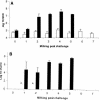MtuA, a lipoprotein receptor antigen from Streptococcus uberis, is responsible for acquisition of manganese during growth in milk and is essential for infection of the lactating bovine mammary gland
- PMID: 12933824
- PMCID: PMC187302
- DOI: 10.1128/IAI.71.9.4842-4849.2003
MtuA, a lipoprotein receptor antigen from Streptococcus uberis, is responsible for acquisition of manganese during growth in milk and is essential for infection of the lactating bovine mammary gland
Abstract
A mutant strain of Streptococcus uberis (AJS001) that was unable to grow in bovine milk was isolated following random insertional mutagenesis. The level of growth in milk was restored to that of the parental strain (strain 0140J) following addition of MnSO(4) but not following addition of other metal ions. The mutant contained a single insertion within mtuA, a homologue of mtsA and psaA, which encode metal-binding proteins in Streptococcus pyogenes and Streptococcus pneumoniae, respectively. Strain AJS001 was unable to infect any of eight quarters on four dairy cows following intramammary challenge with 10(5) CFU. Bacteria were never recovered directly from milk of these animals but were detected following enrichment in Todd-Hewitt broth in three of eight milk samples obtained within 24 h of challenge. The animals showed no inflammatory response and no signs of mastitis. Three mammary quarters on two different animals simultaneously challenged with 600 CFU of the parental strain, strain 0140J, became colonized, shed high numbers of S. uberis organisms in milk, displayed a marked inflammatory response to infection, and showed overt signs of mastitis. These data indicate that mtuA was required for efficient uptake of Mn(2+) during growth in bovine milk and infection of the lactating bovine mammary gland.
Figures






Similar articles
-
Potential factors involved in the early pathogenesis of Streptococcus uberis mastitis: a review.Folia Microbiol (Praha). 2021 Aug;66(4):509-523. doi: 10.1007/s12223-021-00879-9. Epub 2021 Jun 3. Folia Microbiol (Praha). 2021. PMID: 34085166 Review.
-
Further studies on the efficacy of a live vaccine against mastitis caused by Streptococcus uberis.Vaccine. 1997 Jul;15(10):1138-43. doi: 10.1016/s0264-410x(96)00307-6. Vaccine. 1997. PMID: 9269059
-
Bovine intramammary infection associated immunogenic surface proteins of Streptococcus uberis.Microb Pathog. 2018 Feb;115:304-311. doi: 10.1016/j.micpath.2017.12.046. Epub 2017 Dec 16. Microb Pathog. 2018. PMID: 29258753
-
The ability of four strains of Streptococcus uberis to induce clinical mastitis after intramammary inoculation in lactating cows.N Z Vet J. 2016 Jul;64(4):218-23. doi: 10.1080/00480169.2016.1157049. Epub 2016 Mar 9. N Z Vet J. 2016. PMID: 26902291
-
Review: Proteomic approaches to control lactational parameters in dairy cows.Animal. 2019 Jul;13(S1):s82-s85. doi: 10.1017/S1751731118003476. Animal. 2019. PMID: 31280743 Review.
Cited by
-
Lipoprotein signal peptides are processed by Lsp and Eep of Streptococcus uberis.J Bacteriol. 2008 Jul;190(13):4641-7. doi: 10.1128/JB.00287-08. Epub 2008 May 9. J Bacteriol. 2008. PMID: 18469106 Free PMC article.
-
In vitro determination of essential genes required by Streptococcus uberis to grow in a complex biological media relating to intramammary infection.Microb Genom. 2025 Jun;11(6):001425. doi: 10.1099/mgen.0.001425. Microb Genom. 2025. PMID: 40526422 Free PMC article.
-
Vru (Sub0144) controls expression of proven and putative virulence determinants and alters the ability of Streptococcus uberis to cause disease in dairy cattle.Microbiology (Reading). 2012 Jun;158(Pt 6):1581-1592. doi: 10.1099/mic.0.055863-0. Epub 2012 Mar 1. Microbiology (Reading). 2012. PMID: 22383474 Free PMC article.
-
Potential factors involved in the early pathogenesis of Streptococcus uberis mastitis: a review.Folia Microbiol (Praha). 2021 Aug;66(4):509-523. doi: 10.1007/s12223-021-00879-9. Epub 2021 Jun 3. Folia Microbiol (Praha). 2021. PMID: 34085166 Review.
-
Identification of a novel streptococcal gene cassette mediating SOS mutagenesis in Streptococcus uberis.J Bacteriol. 2007 Jul;189(14):5210-22. doi: 10.1128/JB.00473-07. Epub 2007 May 18. J Bacteriol. 2007. PMID: 17513475 Free PMC article.
References
-
- Arnold, C., and I. J. Hodgson. 1991. Vectorette PCR: a novel approach to genomic walking. PCR Methods Appl. 1:39-42. - PubMed
-
- Briles, D. E., R. C. Tart, E. Swiatlo, J. P. Dillard, P. Smith, K. A. Benton, B. A. Ralph, A. Brooks-Walter, M. J. Crain, S. K. Hollingshead, and L. S. McDaniel. 1998. Pneumococcal diversity: considerations for new vaccine strategies with emphasis on pneumococcal surface protein A (PspA). Clin. Microbiol. Rev. 11:645-657. - PMC - PubMed
MeSH terms
Substances
Associated data
- Actions
LinkOut - more resources
Full Text Sources

